key Abarth 500 2020 Owner handbook (in English)
[x] Cancel search | Manufacturer: ABARTH, Model Year: 2020, Model line: 500, Model: Abarth 500 2020Pages: 196, PDF Size: 3.53 MB
Page 60 of 196
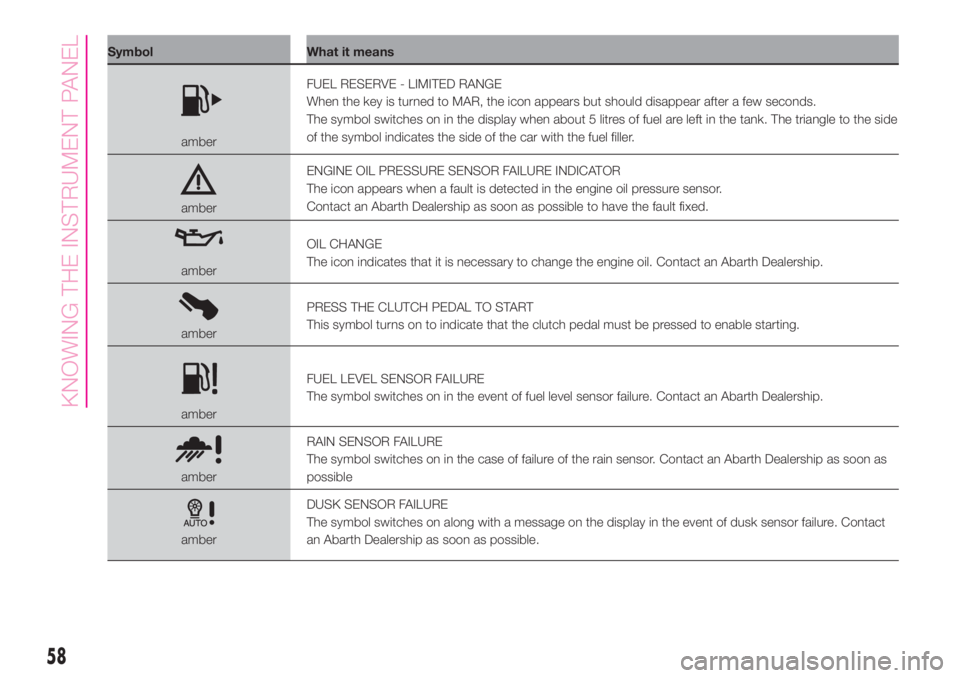
Symbol What it means
amberFUEL RESERVE - LIMITED RANGE
When the key is turned to MAR, the icon appears but should disappear after a few seconds.
The symbol switches on in the display when about 5 litres of fuel are left in the tank. The triangle to the side
of the symbol indicates the side of the car with the fuel filler.
amberENGINE OIL PRESSURE SENSOR FAILURE INDICATOR
The icon appears when a fault is detected in the engine oil pressure sensor.
Contact an Abarth Dealership as soon as possible to have the fault fixed.
amberOIL CHANGE
The icon indicates that it is necessary to change the engine oil. Contact an Abarth Dealership.
amberPRESS THE CLUTCH PEDAL TO START
This symbol turns on to indicate that the clutch pedal must be pressed to enable starting.
amberFUEL LEVEL SENSOR FAILURE
The symbol switches on in the event of fuel level sensor failure. Contact an Abarth Dealership.
amberRAIN SENSOR FAILURE
The symbol switches on in the case of failure of the rain sensor. Contact an Abarth Dealership as soon as
possible
amberDUSK SENSOR FAILURE
The symbol switches on along with a message on the display in the event of dusk sensor failure. Contact
an Abarth Dealership as soon as possible.
58
KNOWING THE INSTRUMENT PANEL
Page 61 of 196

Symbol What it means
whiteHEADLIGHT ALIGNMENT CORRECTOR
The icon, together with a number, indicates the depth of the dipped beam.
WARNING
34)If, when turning the key to MAR, thewarning light does not switch on or if it stays on when travelling, there could be a fault in the
restraint systems; in this event airbags or pretensioners may not be deployed in the event of impact or, in a lower number of cases, they may
deploy accidentally. Before driving off, contact an Abarth Dealership to have the system checked immediately.
35)A failure of the
warning light is indicated by thesymbol on the display. In this case, thewarning light may not indicate a
possible problem with the airbag restraint system. Before driving off, contact an Abarth Dealership to have the system checked immediately.
36)If the
warning light turns on when travelling (on certain versions together with the message on the display) stop the vehicle
immediately and contact an Abarth Dealership.
37)If the
warning light switches on when driving (on certain versions together with a dedicated message on the display) stop the engine
immediately and contact an Abarth Dealership.
38)If the warning light flashes or the symbol is constantly on, depending on the versions, there is a fault in the system. If this is the case, go
to an Abarth Dealership to have the system checked.
39)If, when the ignition key is turned to MAR, the
warning light does not switch on, switches on constantly or flashes while driving (on
certain versions together with the message on the display), contact an Abarth Dealership as soon as possible. The operation of the
warning light may be checked by the traffic police using specific devices. Comply with the laws and regulations of the country where you
are driving.
WARNING
15)If there is a fault in the gearbox, contact an Abarth Dealership as soon as possible to check the system.
59
Page 67 of 196
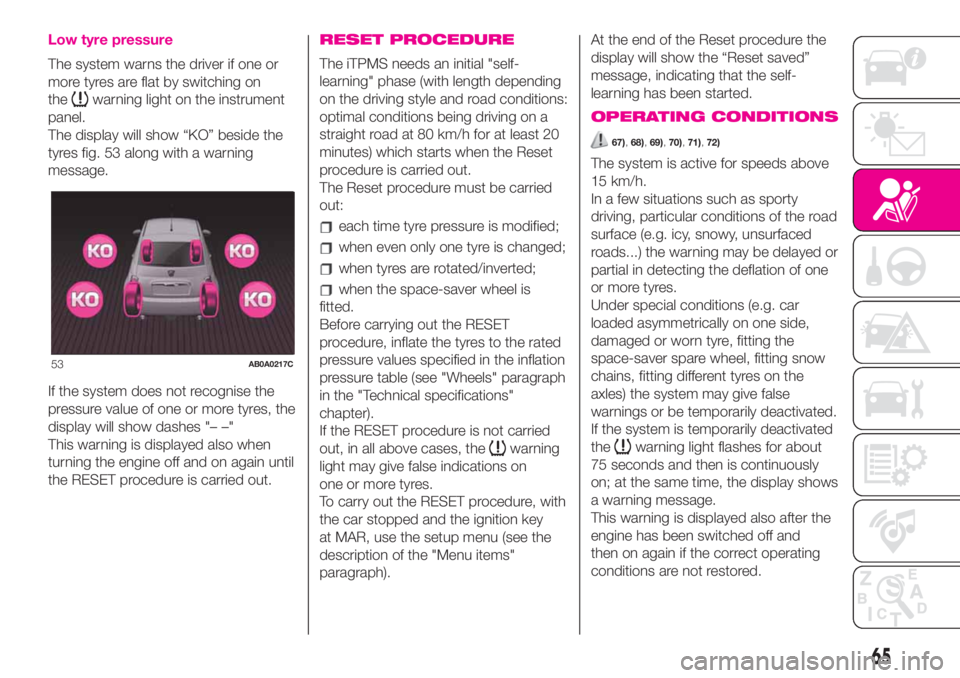
Low tyre pressure
The system warns the driver if one or
more tyres are flat by switching on
the
warning light on the instrument
panel.
The display will show “KO” beside the
tyres fig. 53 along with a warning
message.
If the system does not recognise the
pressure value of one or more tyres, the
display will show dashes "– –"
This warning is displayed also when
turning the engine off and on again until
the RESET procedure is carried out.
RESET PROCEDURE
The iTPMS needs an initial "self-
learning" phase (with length depending
on the driving style and road conditions:
optimal conditions being driving on a
straight road at 80 km/h for at least 20
minutes) which starts when the Reset
procedure is carried out.
The Reset procedure must be carried
out:
each time tyre pressure is modified;
when even only one tyre is changed;
when tyres are rotated/inverted;
when the space-saver wheel is
fitted.
Before carrying out the RESET
procedure, inflate the tyres to the rated
pressure values specified in the inflation
pressure table (see "Wheels" paragraph
in the "Technical specifications"
chapter).
If the RESET procedure is not carried
out, in all above cases, the
warning
light may give false indications on
one or more tyres.
To carry out the RESET procedure, with
the car stopped and the ignition key
at MAR, use the setup menu (see the
description of the "Menu items"
paragraph).At the end of the Reset procedure the
display will show the “Reset saved”
message, indicating that the self-
learning has been started.
OPERATING CONDITIONS
67),68),69),70),71),72)
The system is active for speeds above
15 km/h.
In a few situations such as sporty
driving, particular conditions of the road
surface (e.g. icy, snowy, unsurfaced
roads...) the warning may be delayed or
partial in detecting the deflation of one
or more tyres.
Under special conditions (e.g. car
loaded asymmetrically on one side,
damaged or worn tyre, fitting the
space-saver spare wheel, fitting snow
chains, fitting different tyres on the
axles) the system may give false
warnings or be temporarily deactivated.
If the system is temporarily deactivated
the
warning light flashes for about
75 seconds and then is continuously
on; at the same time, the display shows
a warning message.
This warning is displayed also after the
engine has been switched off and
then on again if the correct operating
conditions are not restored.
53AB0A0217C
65
Page 84 of 196
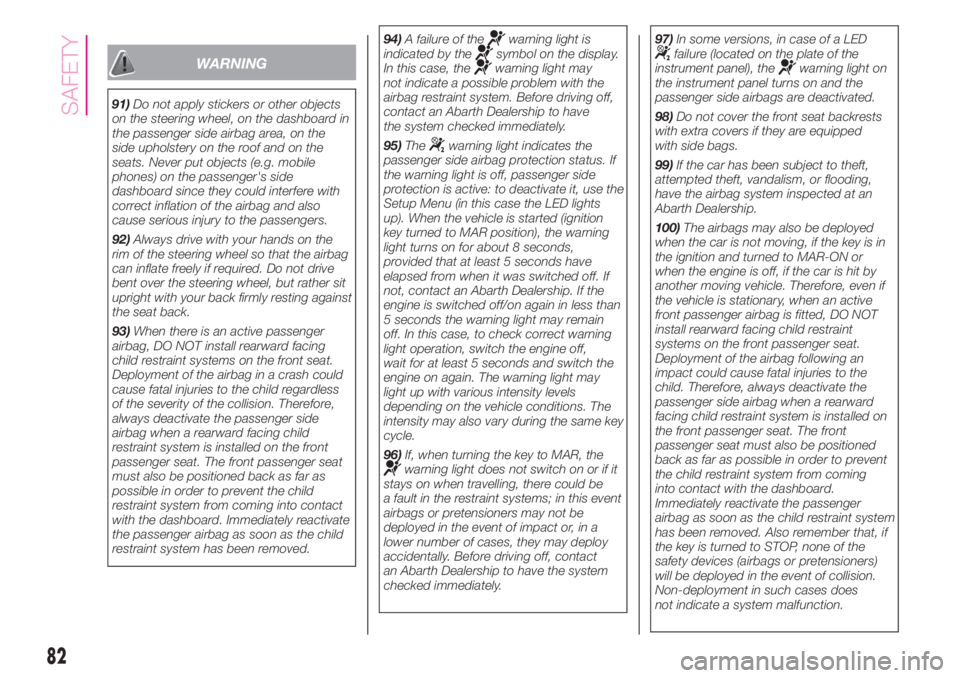
WARNING
91)Do not apply stickers or other objects
on the steering wheel, on the dashboard in
the passenger side airbag area, on the
side upholstery on the roof and on the
seats. Never put objects (e.g. mobile
phones) on the passenger's side
dashboard since they could interfere with
correct inflation of the airbag and also
cause serious injury to the passengers.
92)Always drive with your hands on the
rim of the steering wheel so that the airbag
can inflate freely if required. Do not drive
bent over the steering wheel, but rather sit
upright with your back firmly resting against
the seat back.
93)When there is an active passenger
airbag, DO NOT install rearward facing
child restraint systems on the front seat.
Deployment of the airbag in a crash could
cause fatal injuries to the child regardless
of the severity of the collision. Therefore,
always deactivate the passenger side
airbag when a rearward facing child
restraint system is installed on the front
passenger seat. The front passenger seat
must also be positioned back as far as
possible in order to prevent the child
restraint system from coming into contact
with the dashboard. Immediately reactivate
the passenger airbag as soon as the child
restraint system has been removed.94)A failure of the
warning light is
indicated by thesymbol on the display.
In this case, thewarning light may
not indicate a possible problem with the
airbag restraint system. Before driving off,
contact an Abarth Dealership to have
the system checked immediately.
95)The
warning light indicates the
passenger side airbag protection status. If
the warning light is off, passenger side
protection is active: to deactivate it, use the
Setup Menu (in this case the LED lights
up). When the vehicle is started (ignition
key turned to MAR position), the warning
light turns on for about 8 seconds,
provided that at least 5 seconds have
elapsed from when it was switched off. If
not, contact an Abarth Dealership. If the
engine is switched off/on again in less than
5 seconds the warning light may remain
off. In this case, to check correct warning
light operation, switch the engine off,
wait for at least 5 seconds and switch the
engine on again. The warning light may
light up with various intensity levels
depending on the vehicle conditions. The
intensity may also vary during the same key
cycle.
96)If, when turning the key to MAR, the
warning light does not switch on or if it
stays on when travelling, there could be
a fault in the restraint systems; in this event
airbags or pretensioners may not be
deployed in the event of impact or, in a
lower number of cases, they may deploy
accidentally. Before driving off, contact
an Abarth Dealership to have the system
checked immediately.97)In some versions, in case of a LED
failure (located on the plate of the
instrument panel), thewarning light on
the instrument panel turns on and the
passenger side airbags are deactivated.
98)Do not cover the front seat backrests
with extra covers if they are equipped
with side bags.
99)If the car has been subject to theft,
attempted theft, vandalism, or flooding,
have the airbag system inspected at an
Abarth Dealership.
100)The airbags may also be deployed
when the car is not moving, if the key is in
the ignition and turned to MAR-ON or
when the engine is off, if the car is hit by
another moving vehicle. Therefore, even if
the vehicle is stationary, when an active
front passenger airbag is fitted, DO NOT
install rearward facing child restraint
systems on the front passenger seat.
Deployment of the airbag following an
impact could cause fatal injuries to the
child. Therefore, always deactivate the
passenger side airbag when a rearward
facing child restraint system is installed on
the front passenger seat. The front
passenger seat must also be positioned
back as far as possible in order to prevent
the child restraint system from coming
into contact with the dashboard.
Immediately reactivate the passenger
airbag as soon as the child restraint system
has been removed. Also remember that, if
the key is turned to STOP, none of the
safety devices (airbags or pretensioners)
will be deployed in the event of collision.
Non-deployment in such cases does
not indicate a system malfunction.
82
SAFETY
Page 85 of 196
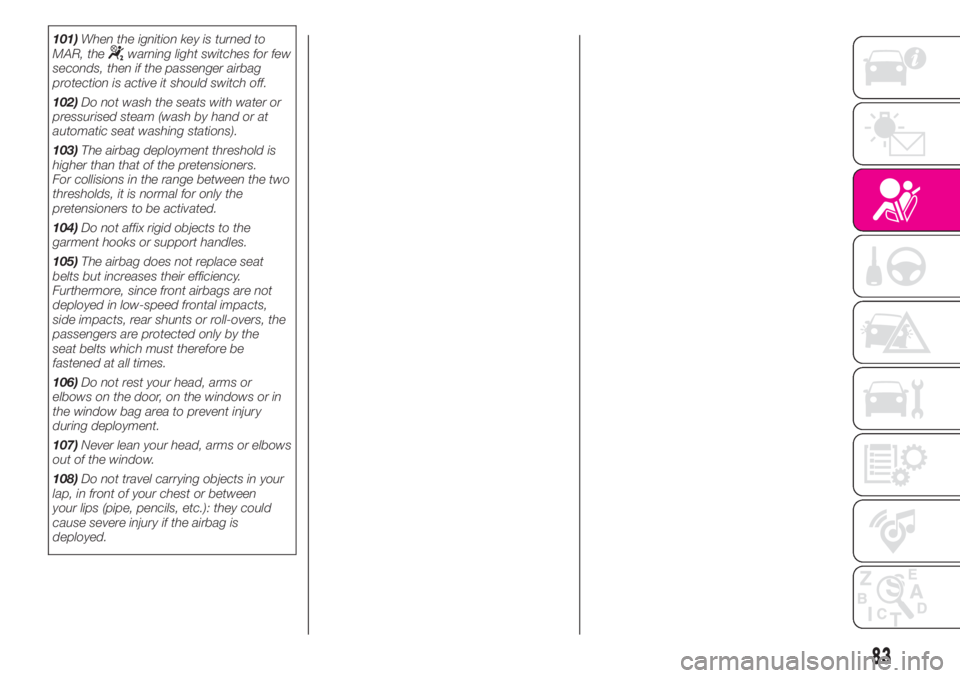
101)When the ignition key is turned to
MAR, thewarning light switches for few
seconds, then if the passenger airbag
protection is active it should switch off.
102)Do not wash the seats with water or
pressurised steam (wash by hand or at
automatic seat washing stations).
103)The airbag deployment threshold is
higher than that of the pretensioners.
For collisions in the range between the two
thresholds, it is normal for only the
pretensioners to be activated.
104)Do not affix rigid objects to the
garment hooks or support handles.
105)The airbag does not replace seat
belts but increases their efficiency.
Furthermore, since front airbags are not
deployed in low-speed frontal impacts,
side impacts, rear shunts or roll-overs, the
passengers are protected only by the
seat belts which must therefore be
fastened at all times.
106)Do not rest your head, arms or
elbows on the door, on the windows or in
the window bag area to prevent injury
during deployment.
107)Never lean your head, arms or elbows
out of the window.
108)Do not travel carrying objects in your
lap, in front of your chest or between
your lips (pipe, pencils, etc.): they could
cause severe injury if the airbag is
deployed.
83
Page 87 of 196
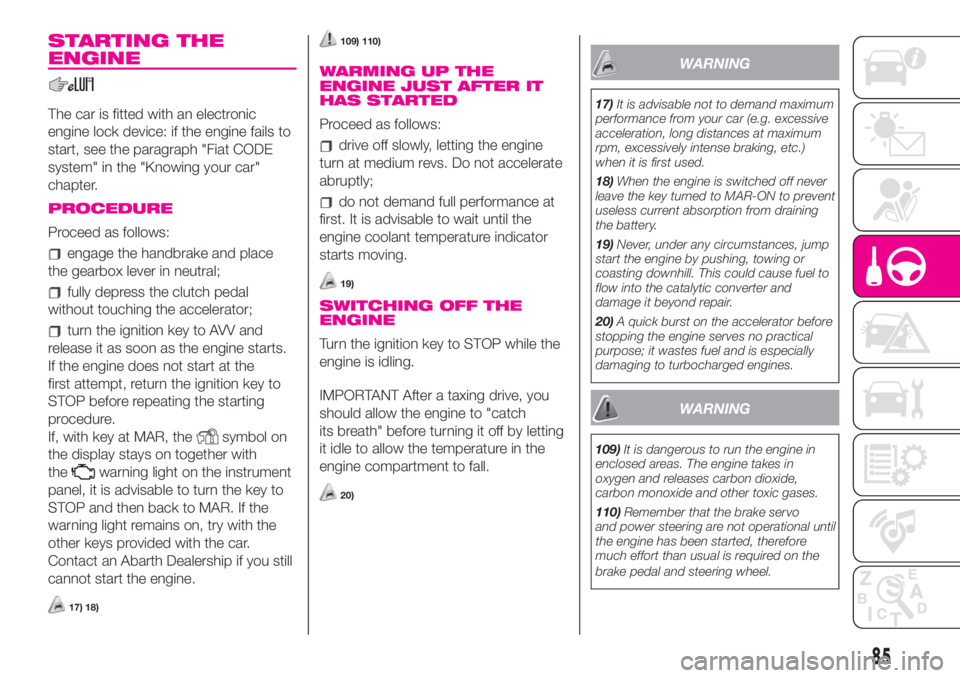
STARTING THE
ENGINE
The car is fitted with an electronic
engine lock device: if the engine fails to
start, see the paragraph "Fiat CODE
system" in the "Knowing your car"
chapter.
PROCEDURE
Proceed as follows:
engage the handbrake and place
the gearbox lever in neutral;
fully depress the clutch pedal
without touching the accelerator;
turn the ignition key to AVV and
release it as soon as the engine starts.
If the engine does not start at the
first attempt, return the ignition key to
STOP before repeating the starting
procedure.
If, with key at MAR, the
symbol on
the display stays on together with
the
warning light on the instrument
panel, it is advisable to turn the key to
STOP and then back to MAR. If the
warning light remains on, try with the
other keys provided with the car.
Contact an Abarth Dealership if you still
cannot start the engine.
17) 18)
109) 110)
WARMING UP THE
ENGINE JUST AFTER IT
HAS STARTED
Proceed as follows:
drive off slowly, letting the engine
turn at medium revs. Do not accelerate
abruptly;
do not demand full performance at
first. It is advisable to wait until the
engine coolant temperature indicator
starts moving.
19)
SWITCHING OFF THE
ENGINE
Turn the ignition key to STOP while the
engine is idling.
IMPORTANT After a taxing drive, you
should allow the engine to "catch
its breath" before turning it off by letting
it idle to allow the temperature in the
engine compartment to fall.
20)
WARNING
17)It is advisable not to demand maximum
performance from your car (e.g. excessive
acceleration, long distances at maximum
rpm, excessively intense braking, etc.)
when it is first used.
18)When the engine is switched off never
leave the key turned to MAR-ON to prevent
useless current absorption from draining
the battery.
19)Never, under any circumstances, jump
start the engine by pushing, towing or
coasting downhill. This could cause fuel to
flow into the catalytic converter and
damage it beyond repair.
20)A quick burst on the accelerator before
stopping the engine serves no practical
purpose; it wastes fuel and is especially
damaging to turbocharged engines.
WARNING
109)It is dangerous to run the engine in
enclosed areas. The engine takes in
oxygen and releases carbon dioxide,
carbon monoxide and other toxic gases.
110)Remember that the brake servo
and power steering are not operational until
the engine has been started, therefore
much effort than usual is required on the
brake pedal and steering wheel.
85
Page 88 of 196
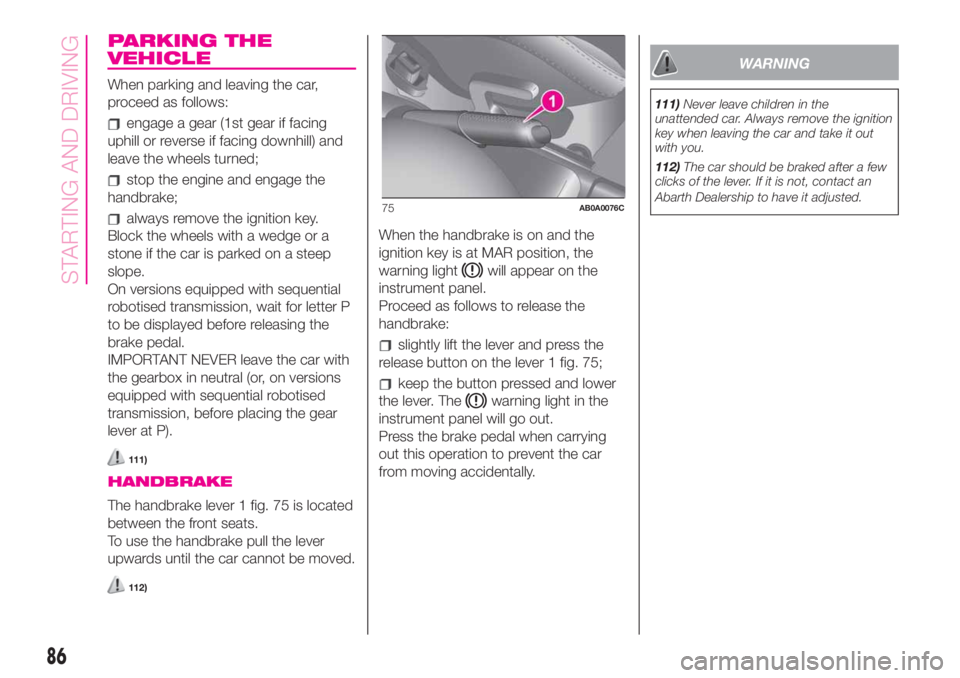
PARKING THE
VEHICLE
When parking and leaving the car,
proceed as follows:
engage a gear (1st gear if facing
uphill or reverse if facing downhill) and
leave the wheels turned;
stop the engine and engage the
handbrake;
always remove the ignition key.
Block the wheels with a wedge or a
stone if the car is parked on a steep
slope.
On versions equipped with sequential
robotised transmission, wait for letter P
to be displayed before releasing the
brake pedal.
IMPORTANT NEVER leave the car with
the gearbox in neutral (or, on versions
equipped with sequential robotised
transmission, before placing the gear
lever at P).
111)
HANDBRAKE
The handbrake lever 1 fig. 75 is located
between the front seats.
To use the handbrake pull the lever
upwards until the car cannot be moved.
112)
When the handbrake is on and the
ignition key is at MAR position, the
warning light
will appear on the
instrument panel.
Proceed as follows to release the
handbrake:
slightly lift the lever and press the
release button on the lever 1 fig. 75;
keep the button pressed and lower
the lever. The
warning light in the
instrument panel will go out.
Press the brake pedal when carrying
out this operation to prevent the car
from moving accidentally.
WARNING
111)Never leave children in the
unattended car. Always remove the ignition
key when leaving the car and take it out
with you.
112)The car should be braked after a few
clicks of the lever. If it is not, contact an
Abarth Dealership to have it adjusted.
75AB0A0076C
86
STARTING AND DRIVING
Page 89 of 196
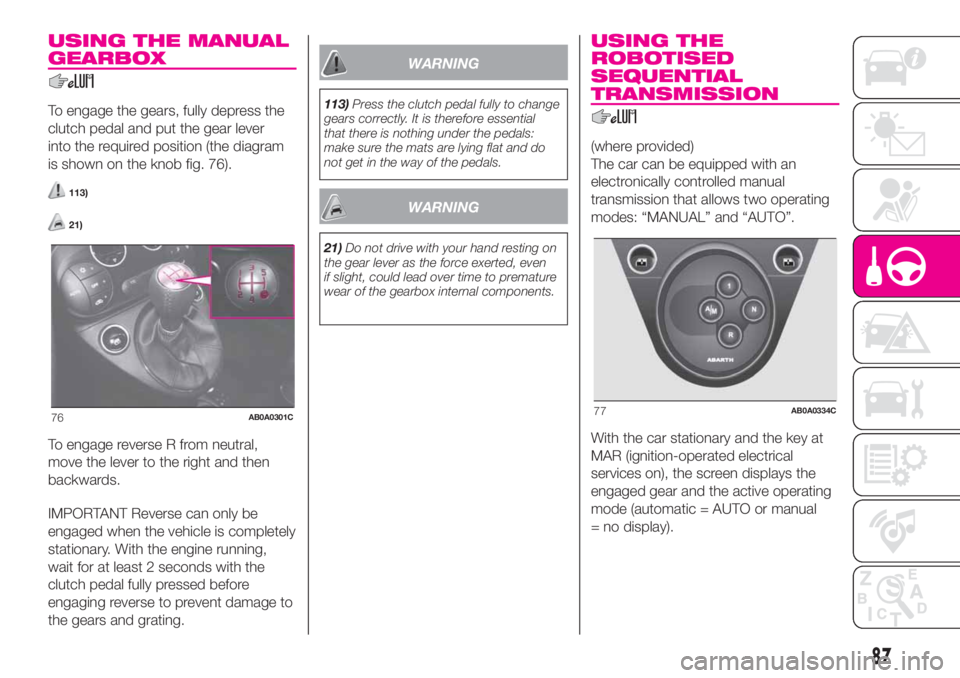
USING THE MANUAL
GEARBOX
To engage the gears, fully depress the
clutch pedal and put the gear lever
into the required position (the diagram
is shown on the knob fig. 76).
113)
21)
To engage reverse R from neutral,
move the lever to the right and then
backwards.
IMPORTANT Reverse can only be
engaged when the vehicle is completely
stationary. With the engine running,
wait for at least 2 seconds with the
clutch pedal fully pressed before
engaging reverse to prevent damage to
the gears and grating.
WARNING
113)Press the clutch pedal fully to change
gears correctly. It is therefore essential
that there is nothing under the pedals:
make sure the mats are lying flat and do
not get in the way of the pedals.
WARNING
21)Do not drive with your hand resting on
the gear lever as the force exerted, even
if slight, could lead over time to premature
wear of the gearbox internal components.
USING THE
ROBOTISED
SEQUENTIAL
TRANSMISSION
(where provided)
The car can be equipped with an
electronically controlled manual
transmission that allows two operating
modes: “MANUAL” and “AUTO”.
With the car stationary and the key at
MAR (ignition-operated electrical
services on), the screen displays the
engaged gear and the active operating
mode (automatic = AUTO or manual
= no display).
76AB0A0301C77AB0A0334C
87
Page 91 of 196
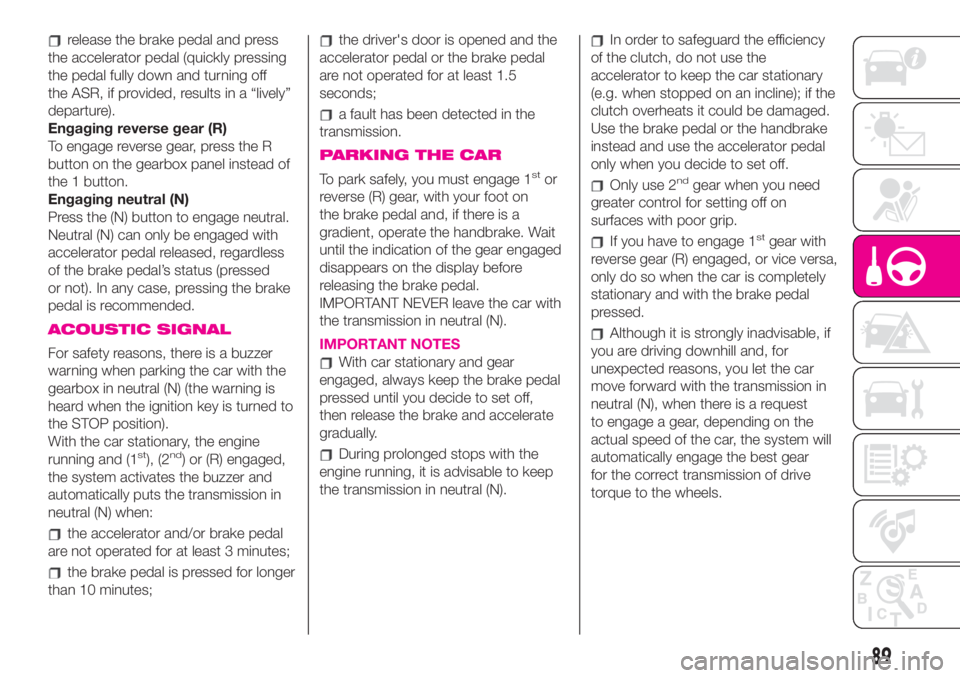
release the brake pedal and press
the accelerator pedal (quickly pressing
the pedal fully down and turning off
the ASR, if provided, results in a “lively”
departure).
Engaging reverse gear (R)
To engage reverse gear, press the R
button on the gearbox panel instead of
the 1 button.
Engaging neutral (N)
Press the (N) button to engage neutral.
Neutral (N) can only be engaged with
accelerator pedal released, regardless
of the brake pedal’s status (pressed
or not). In any case, pressing the brake
pedal is recommended.
ACOUSTIC SIGNAL
For safety reasons, there is a buzzer
warning when parking the car with the
gearbox in neutral (N) (the warning is
heard when the ignition key is turned to
the STOP position).
With the car stationary, the engine
running and (1
st), (2nd) or (R) engaged,
the system activates the buzzer and
automatically puts the transmission in
neutral (N) when:
the accelerator and/or brake pedal
are not operated for at least 3 minutes;
the brake pedal is pressed for longer
than 10 minutes;
the driver's door is opened and the
accelerator pedal or the brake pedal
are not operated for at least 1.5
seconds;
a fault has been detected in the
transmission.
PARKING THE CAR
To park safely, you must engage 1stor
reverse (R) gear, with your foot on
the brake pedal and, if there is a
gradient, operate the handbrake. Wait
until the indication of the gear engaged
disappears on the display before
releasing the brake pedal.
IMPORTANT NEVER leave the car with
the transmission in neutral (N).
IMPORTANT NOTES
With car stationary and gear
engaged, always keep the brake pedal
pressed until you decide to set off,
then release the brake and accelerate
gradually.
During prolonged stops with the
engine running, it is advisable to keep
the transmission in neutral (N).
In order to safeguard the efficiency
of the clutch, do not use the
accelerator to keep the car stationary
(e.g. when stopped on an incline); if the
clutch overheats it could be damaged.
Use the brake pedal or the handbrake
instead and use the accelerator pedal
only when you decide to set off.
Only use 2ndgear when you need
greater control for setting off on
surfaces with poor grip.
If you have to engage 1stgear with
reverse gear (R) engaged, or vice versa,
only do so when the car is completely
stationary and with the brake pedal
pressed.
Although it is strongly inadvisable, if
you are driving downhill and, for
unexpected reasons, you let the car
move forward with the transmission in
neutral (N), when there is a request
to engage a gear, depending on the
actual speed of the car, the system will
automatically engage the best gear
for the correct transmission of drive
torque to the wheels.
89
Page 92 of 196

When necessary, you can engage
1stgear, reverse (R) or neutral (N) with
the engine off, the key at AVV and
the brake pressed. In this case, it is
advisable to change allowing at least 5
seconds to elapse between one gear
change and the next to safeguard
the operation of the hydraulic system
and the pump in particular.
Fully and quickly depressing the
accelerator pedal activates a function
that allows a "lively" departure.
For starting uphill, accelerating
gradually but fully immediately after
having released the handbrake or the
brake pedal allows the engine to greatly
increase the rpm and tackle the
steepest gradients with more torque to
the wheels.
WARNING
22)Using the levers incorrectly (levers
pushed towards the dashboard) could
break them.
SPORT FUNCTION
When the SPORT button 1 fig. 79 is
pressed, the sports driving setting
is turned on giving greater
responsiveness during acceleration, an
increase in drive torque and more
precise steering with greater effort
required on the steering wheel.
When this function is on, the word
SPORT 1 fig. 80 is lit up in the display
and the instrument panel shows a
dedicated screen.
Press the button again to turn the
function off and restore the normal
driving setting.
IMPORTANT When the SPORT button
is pressed, the function is activated
about 5 seconds later.IMPORTANT During acceleration, when
the SPORT function is used, the
steering may shudder, which is typical
of a sports setting.
NOTE For vehicles equipped with an
Akrapovic exhaust system, a
considerable increase in engine sound
can be heard when the SPORT mode is
activated. This is caused by opening
the valve located in the Akrapovic
exhaust, which improves performance.
79AB0A0351C
80AB0A0360C
90
STARTING AND DRIVING